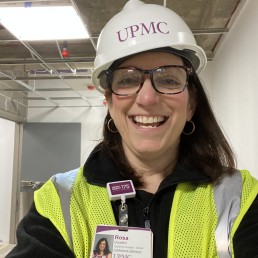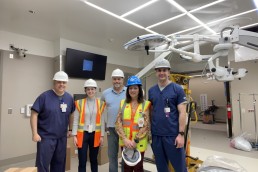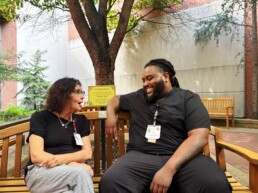In May 2023, UPMC celebrated the grand opening of its newest facility, UPMC Mercy Pavilion. This cutting-edge patient care center is the first of its kind in the nation — a place of life-changing care for people with specialized vision or rehabilitation needs. With a patient-centric, mobility-minded design and extensive features including eight eye disease operating rooms, 83 eye exam rooms, 10 rehab exam rooms, and 100,600 square feet of research space, UPMC Mercy Pavilion offers comprehensive care for patients with rehab and vision needs.
Constructing and opening such an innovative facility involved the all-hands-on-deck efforts of many teams across UPMC. Today, we’re spotlighting one of the teams that played a key role in the launch of UPMC Mercy Pavilion – Information Technology.
From installing devices and medical equipment to training clinical staff on new technology, IT helped make the transition to UPMC Mercy Pavilion a seamless one for everyone involved – and provided the team with a unique and rewarding experience along the way. Let’s here from some members of UPMC’s IT team about what the journey to UPMC Mercy Pavilion was like for them!
"Being able to watch the building fill with patients and use the equipment we spent so much time setting up and testing made the work we do truly feel impactful to the patients and the community."
— Anne C., Associate Project Manager, IT
Rosa: Systems Analyst - Senior
I helped to support the UPMC Mercy Pavilion go-live in many ways, including assisting with initial set-up and testing of devices and patient access areas. My team helped to set up the Pavilion’s new operating rooms, recovery rooms, and pharmacy areas, which included training physicians and nurses on the new technology.
I have many happy memories from the work we all did at the Pavilion. It was a huge effort by all involved, and it felt so wonderful when everything was up and running! My favorite memories included our many testing events, go-live support in the command center, and all the fun I had wandering the maze of construction as the building was going up.
As the local IT team here at UPMC Mercy, we are dedicated to our users and work hard every day to support them. We are their support when new equipment and software are needed, and we assist daily in all their IT issues. We show dignity and respect to all that we serve and make ourselves easily available to them, allowing our clinical staff to work more efficiently with technology.


Anne: Associate Project Manager, IT
I am an IT Project Manager with the IT Integration Services Team, which manages IT for hospital construction and acquisitions. We managed all the IT for the Mercy Pavilion from computers to medical equipment. During go-live, and the weeks and months leading up to it, we were on-site to help troubleshoot issues and ensure no IT issues disrupted patient care. The most unique part of the experience was navigating the building with only floor plans and wearing a hard hat for a few months while we worked to get medical equipment and computers installed.
In IT, it is easy to feel that what we do does not impact the patient, but that could not be further from the truth. We support the charts the clinicians type in when seeing a patient, the computers they use, the printers they print, copy, and fax on, and the medical equipment they use for imaging. In reality, the IT footprint is woven into every piece of patient care. Being able to watch the building fill with patients and use the equipment we spent so much time setting up and testing made the work we do truly feel impactful to the patients and the community.
Katharine: Sr. Project Manager, IT
My team, IT Integration Services, provided project management services for the UPMC Mercy Pavilion project. Our team managed multiple aspects of the project from an IT perspective, such as bringing up the UPMC network, IT hardware deployments, clinical systems integration, and medical equipment implementations.
In addition to the several years of planning, we organized the IT Command Center for the May 2023 go-live and supported staff both on-site and virtually for more than two weeks. During those first few weeks after go-live, we helped triage any issues that arose and organized IT task forces to troubleshoot until a resolution was found. I personally enjoyed the time spent rounding to check in with clinical and operational staff to ensure their systems and hardware were functioning as expected.
A memorable moment for me occurred in the early morning of May 1, as staff began to arrive to the new building, some for the very first time. As I was rounding, there was a woman getting settled in as a reception staff for one of the rehabilitation clinics. As she attempted to orient herself to the new building and to her new workspace, she requested to have her label printer moved to a different side of the desk and asked if I could find someone to help her. I had overseen and even assisted in the deployment of some label printers, so I knew I could quickly help her. To her surprise, I proceeded to crawl under the desk to move cables around and had the printer relocated within a few minutes.
In my eyes this was the least I could do for her, but to her, it was much more. She found comfort in having her equipment where she needed it to support the registration workflow that she was used to. She expressed a lot of gratitude and said, “Now I’m ready to start this new chapter here.” With that confidence, she was able to greet her patients and get them checked in for their appointments.


Michael S.: Project Manager, IT
As part of the IT Integration Services team, our primary focus is Hospital Integrations and Major Construction Projects, where we provide IT project management. Our team acts as a single point of contact between UPMC IT and our non-IT project stakeholders.
Looking back at the Mercy Pavilion project, what stands out most to me is the amount of technology that is incorporated into every aspect of the building. We have implemented the latest and greatest clinical equipment for all types of eye care for this project, but there is also an incredible amount of technology you might not expect. For example, our elevator system uses artificial intelligence to maximize trip efficiency and minimize wait times. Additionally, our conference rooms can track active speakers during a video call and zoom in on them to enhance the meeting experience for remote attendees. My team had the opportunity to assist with IT integration for dozens of these mini projects at UPMC Mercy Pavilion.
The experience of seeing something start as a concept on paper and fostering its growth into a fully functioning system that patients and staff will use every day for many years to come was certainly rewarding.
"The experience of seeing something start as a concept on paper and fostering its growth into a fully functioning system that patients and staff will use every day for many years to come was certainly rewarding."
— Michael S., Project Manager, IT





